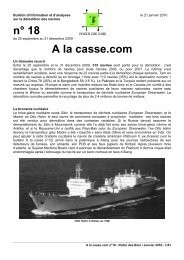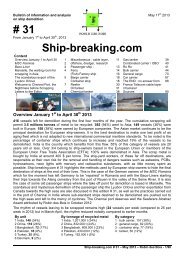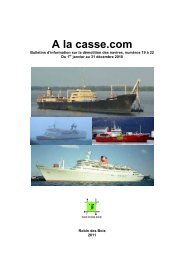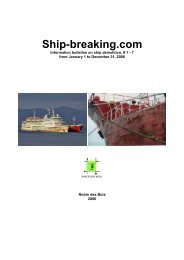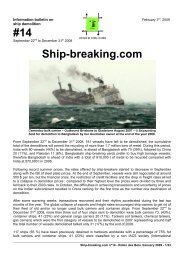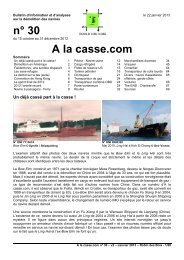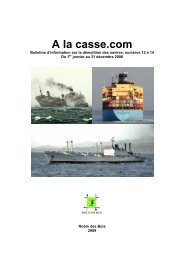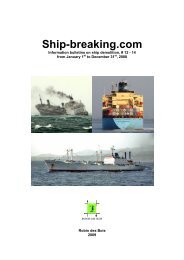Ship-breaking.com - Robin des Bois
Ship-breaking.com - Robin des Bois
Ship-breaking.com - Robin des Bois
You also want an ePaper? Increase the reach of your titles
YUMPU automatically turns print PDFs into web optimized ePapers that Google loves.
Information and analysis bulletin April 21, 2010<br />
on ship demolition<br />
# 19<br />
January 1st to April 4th 2010<br />
<strong>Ship</strong>-<strong>breaking</strong>.<strong>com</strong><br />
Between January 1st and April 4th 2010, 233 ships were sent to be demolished. The rhythm remains<br />
elevated, with 18 ships per week. In number of ships to be demolished as well as tonnage, India, with<br />
120 ships (42%), remains <strong>des</strong>tination number 1 before Bangla<strong>des</strong>h with 55 (24%), Pakistan with 25<br />
(11%), and China with 23 (9%). The accumulated demolition will permit the recycling of nearly 2 million<br />
tons of metal.<br />
The crisis is over !<br />
The prices offered by the demolition yards have significantly increased and continue to increase in the<br />
yards of the Indian subcontinent, but also in China; they have reached $400, even $500 for oil tankers<br />
and more for ships containing stainless steel. The record of the trimester was obtained by the Norwegian<br />
chemical tanker Spirit, bought for $780 per ton by an Indian yard, a price rarely reached even in 2008.<br />
The twilight of tankers<br />
There has been a great return of tankers, which began in the last trimester. While in 2009 they<br />
represented less than 20% of demolished ships, oil, chemical and gas tankers constituted the largest<br />
category of ships going to the <strong>breaking</strong> yards this trimester with 95 ships (41%). Despite announcements<br />
of an alleged boom in their demolition, only 37 were single-hull tankers. Their median age is 26.6 years<br />
while it is only 24.3 years for double-hull, double-bottom or double-wall ships, perhaps a sign that the<br />
difficulty of their upkeep shortens their careers. General cargo ships, with 53 (23%) as well as container<br />
ships with 27 (12%) and bulk carriers with 23 (10%) are marking time. In volume, the tankers together<br />
represent more than 1 million tons, or 55%, of recycled metal. 11 VLCC (Very Large Crude Carrier) were<br />
sent to the <strong>breaking</strong> yards. A number of ancient oil tankers, used for years as floating storage and<br />
without self propulsion, arrived at the end of their lives. For example, the case of the fifty year old<br />
Brazilian Presidente Floriano, the demolition of which was announced in 2003, but which continued<br />
acting as floating storage in the Amazon. The ship, towed from Manaus, was received at Alang as a<br />
“dead vessel.”(see p 9).<br />
Presidente Floriano, August 14th, 2008, Manaus, Brazil. Launched in 1960, she is a true sistership to the Speedol<br />
Star from « Tintin and the Land of Black Gold » (1950). © Vladimir Knyaz<br />
A rudderless Europe<br />
Unlike Japan, which has just financially contributed to the experimental dismantling of the car carrier<br />
New York Highway in the local <strong>breaking</strong> yard of Muroran (see p 31), the European Union delays putting<br />
into reality its potentially good and <strong>com</strong>passionate resolutions concerning the dismantling of ships.<br />
Despite the proposals and consultation of the Environmental Directorate of the European Commission,<br />
___________________________________________________________________________________________<br />
<strong>Ship</strong>-<strong>breaking</strong>.<strong>com</strong> #°19 - <strong>Robin</strong> <strong>des</strong> <strong>Bois</strong> / April 2010 - 1/31



